
The Bible has been translated into multiple Philippine languages (with regional languages colloquially referred to as dialects), including Filipino language, based on the Tagalog (the major language), the national language of the Philippines.

The Bible has been translated into multiple Philippine languages (with regional languages colloquially referred to as dialects), including Filipino language, based on the Tagalog (the major language), the national language of the Philippines.
Portions of the Bible were first translated by Spanish friars into the Philippine languages in the catechisms and prayer materials they produced. The Doctrina Cristiana (1593) was the first book published in the Tagalog baybayin script.
Protestants published Ang Biblia (American Standard Version) in 1905 in Tagalog, based on the Spanish version of the Protestant canon. Most Protestant denominations use the New International Version of the Bible.
However, mainline Protestant denominations in the Philippines tend to prefer the Magandang Balita Biblia (Good News Bible). The Iglesia ni Cristo also uses the same translation. Jehovah's Witnesses use their own translation of the Bible, the Bagong Sanlibutang Salin (New World Translation) which is published in Tagalog, 2000 edition, 2019 revision. [1] [2]
The Philippine Bible Society has translated the Bible into other major Philippine languages, namely: Ilocano, Pangasinan, Kapampangan, Bicolano, Hiligaynon, Waray, Zamboangueño and Cebuano. Each of these languages has at least two Bible versions published by the society: one formal equivalence translation (mainly used among conservative Protestants), and one dynamic equivalence translation (available with or without the deuterocanonical books).
In addition to the Tagalog translation of Jose Abriol, the Catholic Church, through the Daughters of St. Paul, publishes Catholic Bibles in Kapampangan, Bicolano, and Waray. Moreover, derivative translations of the Christian Community Bible published by the Claretians are also available in Hiligaynon (Biblia sang Katilingban sang mga Kristiano) and Cebuano (Biblia sa Kristohanong Katilingban).
The Jehovah's Witnesses also translate their Bible, the New World Translation of the Holy Scriptures , into several regional languages such as Cebuano (2000 edition, 2019 revision); [3] [4] Hiligaynon (2007, 2014 edition); [5] [6] Iloko (2000 edition, 2018 revision); [7] [8] Pangasinan (2009, 2015 edition); [9] Bicol (2016 edition); [10] and Waray-Waray (2012, 2019 edition). [3] [11]

Other languages of the Philippines:
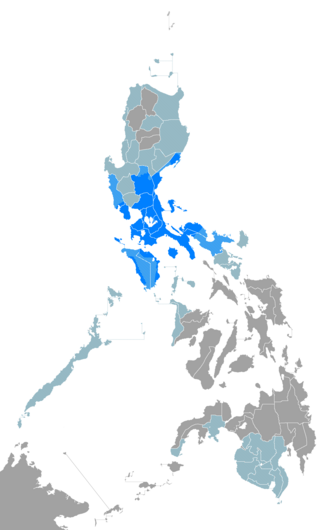
Tagalog is an Austronesian language spoken as a first language by the ethnic Tagalog people, who make up a quarter of the population of the Philippines, and as a second language by the majority. Its standardized form, officially named Filipino, is the national language of the Philippines, and is one of two official languages, alongside English.

Filipino is a language under the Austronesian language family. It is the national language of the Philippines, and one of the two official languages of the country, with English. It is a standardized variety of Tagalog based on the native dialect, spoken and written, in Metro Manila, the National Capital Region, and in other urban centers of the archipelago. The 1987 Constitution mandates that Filipino be further enriched and developed by the other languages of the Philippines.
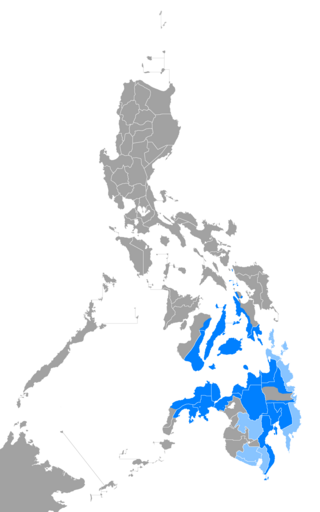
Cebuano is an Austronesian language spoken in the southern Philippines. It is natively, though informally, called by its generic term Bisayâ or Binisayâ and sometimes referred to in English sources as Cebuan. It is spoken by the Visayan ethnolinguistic groups native to the islands of Cebu, Bohol, Siquijor, the eastern half of Negros, the western half of Leyte, and the northern coastal areas of Northern Mindanao and the eastern part of Zamboanga del Norte due to Spanish settlements during 18th century. In modern times, it has also spread to the Davao Region, Cotabato, Camiguin, parts of the Dinagat Islands, and the lowland regions of Caraga, often displacing native languages in those areas.

The Bisayan languages or Visayan languages are a subgroup of the Austronesian languages spoken in the Philippines. They are most closely related to Tagalog and the Bikol languages, all of which are part of the Central Philippine languages. Most Bisayan languages are spoken in the whole Visayas section of the country, but they are also spoken in the southern part of the Bicol Region, islands south of Luzon, such as those that make up Romblon, most of the areas of Mindanao and the province of Sulu located southwest of Mindanao. Some residents of Metro Manila also speak one of the Bisayan languages.
The Central Philippine languages are the most geographically widespread demonstrated group of languages in the Philippines, being spoken in southern Luzon, Visayas, Mindanao, and Sulu. They are also the most populous, including Tagalog, Bikol, and the major Visayan languages Cebuano, Hiligaynon, Waray, Kinaray-a, and Tausug, with some forty languages all together.
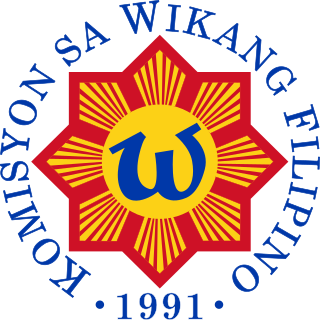
The Commission on the Filipino Language (CFL), also referred to as the Komisyon sa Wikang Filipino (KWF), is the official regulating body of the Filipino language and the official government institution tasked with developing, preserving, and promoting the various local Philippine languages. The commission was established in accordance with the 1987 Constitution of the Philippines.
The Christian Community Bible is a translation of the Christian Bible in the English language originally produced in the Philippines.

Poro, officially the Municipality of Poro, is a 4th class municipality in the province of Cebu, Philippines. According to the 2020 census, it has a population of 26,232 people.

The Waray people are a subgroup of the larger ethnolinguistic group Bisaya people, who constitute the 4th largest Filipino ethnolinguistic group in the Philippines. Their primary language is the Waray language, an Austronesian language native to the islands of Samar, Leyte and Biliran, which together comprise the Eastern Visayas Region of the Philippines. Waray people inhabit most of Samar where they are called Samareños/Samarnons, the northern part of the island of Leyte where they are called Leyteños, and the island of Biliran. In Leyte island, the Waray-speaking people are separated from the Cebuano-speaking Leyteños by the island's mountain range at the middle.
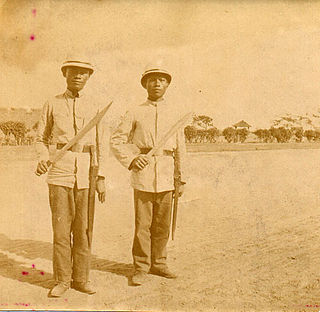
The Cebuano people are the largest subgroup of the larger ethnolinguistic group Visayans, who constitute the largest Filipino ethnolinguistic group in the country. They originated in the province of Cebu in the region of Central Visayas, but then later spread out to other places in the Philippines, such as Siquijor, Bohol, Negros Oriental, southwestern Leyte, western Samar, Masbate, and large parts of Mindanao. It may also refer to the ethnic group who speak the same language as their native tongue in different parts of the archipelago. The term Cebuano also refers to the demonym of permanent residents in Cebu island regardless of ethnicity.
The Magandang Balita Biblia is a Christian Bible in the Tagalog language, first published by the Philippine Bible Society in 1973. It follows the tradition of the Good News Bible; however, it is not a direct translation but rather only a parallel translation of it.
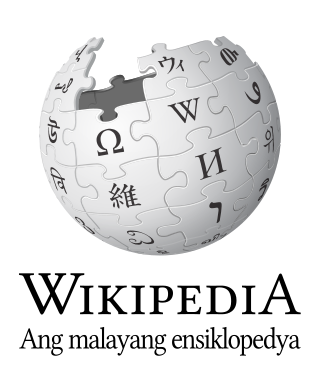
The Tagalog Wikipedia is the Tagalog language edition of Wikipedia, which was launched on December 1, 2003. It has 47,178 articles and is the 103rd largest Wikipedia according to the number of articles as of April 23, 2024.
The Ilocano Bible, published in 1909, is the second Bible to be published in any Philippine language, after the Tagalog which was published in 1905.
Bisalog, also Tagbis, is a portmanteau of the words "Bisaya" and "Tagalog", referring to either a Visayan language or Tagalog being infused with words or expressions from the other. It can also be an informal term for Visayan languages spoken in Mimaropa, or Tagalog dialects infused with words from Visayan languages spoken there, such as in Marinduque.
Rev. Msgr. Jose C. Abriol was a Filipino Catholic priest, linguist, and high official in the church in the Philippines. He was the first to translate the Catholic Bible into Tagalog, the native language for most Filipinos.

Latík refers to two different coconut-based ingredients in Filipino cuisine. In the Visayan region it refers to a syrupy caramelized coconut cream used as a dessert sauce. In the northern Philippines, it refers to solid byproducts of coconut oil production, used as garnishing for a variety of desserts.

Hiligaynon, also often referred to as Ilonggo or Binisaya/Bisaya nga Hiniligaynon/Inilonggo, is an Austronesian regional language spoken in the Philippines by about 9.1 million people, predominantly in Western Visayas and Soccsksargen, most of whom belong to the Hiligaynon people. It is the second-most widely spoken language in the Visayas and belongs to the Bisayan languages, and it is more distantly related to other Philippine languages.
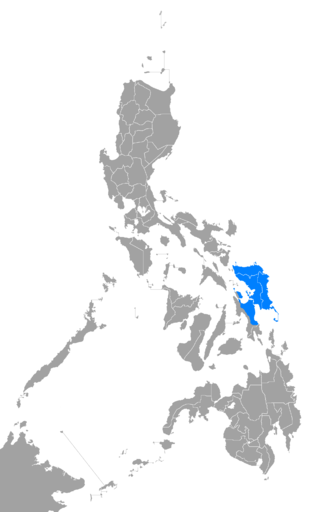
Waray is an Austronesian language and the fifth-most-spoken native regional language of the Philippines, native to Eastern Visayas. It is the native language of the Waray people and second language of the Abaknon people of Capul, Northern Samar, and some Cebuano-speaking peoples of western and southern parts of Leyte island. It is the third most spoken language among the Bisayan languages, only behind Cebuano and Hiligaynon.
David Michael M. San Juan is a Filipino Marxist writer, researcher, activist, and professor. He was chosen Mananaysay ng Taon in 2009 and Makata ng Taon in 2010 by the Komisyon sa Wikang Filipino.
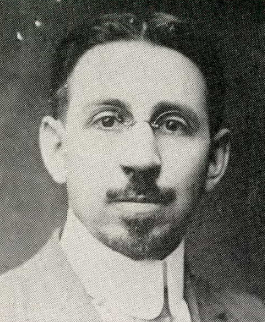
Carlos Everett Conant was an American linguist who specialized in Austronesian languages, particularly the languages of the Philippines. He was also one of the founding members of the Linguistic Society of America.